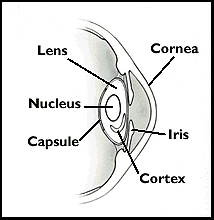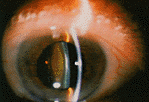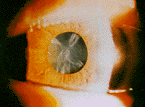CATARACT
What Is a Cataract?
A cataract is a cloudy or opaque area in the normally transparent lens of the eye. As
the opacity thickens, it prevents light rays from passing through the lens and focusing on
the retina, the light sensitive tissue lining the back of the eye. Early lens changes or
opacities may not disturb vision. But as the lens continues to change, several specific
symptoms including blurred vision; sensitivity to light and glare; increased
nearsightedness; or distorted images in either eye, may develop.
The lens is located behind the iris, the colored portion of the eye, and the
pupil, the dark center of the eye. Tiny ligaments, called zonules, support the lens
capsule within the eye.

The lens has three parts, the capsule, the nucleus, and the cortex.
The outer membrane, or capsule, surrounds the cortex which in turn surrounds the
center or nucleus of the lens. If you imagine the lens as a piece of fruit, the capsule is
the skin, the cortex is the fleshy fruit, and the nucleus is the pit.
Types of Cataracts
There are three types of cataracts. Each is described by its location on the lens. The
most common type of cataract and the one associated with aging is called a nuclear
cataract.
 A nuclear cataract occurs in the center of the lens. Common symptoms
include blurring or dimming of your vision, glare and visual distortion. A nuclear
cataract can induce myopia, or nearsightedness, a temporary improvement in your reading
vision sometimes referred to as "second sight." Unfortunately "second
sight" disappears as the cataract gets worse. A nuclear cataract occurs in the center of the lens. Common symptoms
include blurring or dimming of your vision, glare and visual distortion. A nuclear
cataract can induce myopia, or nearsightedness, a temporary improvement in your reading
vision sometimes referred to as "second sight." Unfortunately "second
sight" disappears as the cataract gets worse.

The cortical cataract begins as wedge-shaped spokes in the cortex
of the lens. The spokes extend from the outside of the lens to the center. When the spokes
reach the center, they interfere with the transmission of light and cause glare and loss
of contrast. Many people with diabetes develop this type of cataract. Although a cortical
cataract usually develops slowly, it may impair both distance and near vision so
significantly that surgery may be suggested at a relatively early stage.

A subcapsular cataract develops slowly and starts as a small opacity under the
capsule, usually at the back of the lens. Significant visual symptoms may not appear until
the cataract is well developed. Typical symptoms are glare and blur. A subcapsular
cataract is often found in people with diabetes or high myopia, adults with retinitis
pigmentosa, and in people taking steroids.
|